This is the Foto-Flex, a twin lens box camera made by the Hadds Mfg. Co. for the Foto-Flex Corporation of Chicago, Illinois starting in 1947. The Foto-Flex was an inexpensive camera made of plastic and stamped metal and makes twelve 4cm x 4cm images on 127 format roll film. It was aimed at the novice photographer and originally sold for $7.95 with an optional flash gun available later. The Foto-Flex was distributed by the Camera Specialty Company of New York and marketed with the slogan, “See it first, then Foto-Flex it.”
Film Type: 127 Roll Film (twelve 4cm x 4cm exposures per roll)
Lens: Unknown Focal Length and Aperture (~65mm, f/16) Cerium Polished Meniscus Single Element
Focus: Fixed, 6 feet to Infinity
Viewfinder: Waist Level Reflex Finder
Shutter: Rotary
Speeds: Timed (Bulb) and Instant (~1/50 second)
Exposure Meter: None
Battery: None
Flash Mount: None
Weight: 359 grams
Manual: https://www.cameramanuals.org/pdf_files/foto-flex.pdf
How these ratings work |
The Foto-Flex is one of many cheaply made cameras from the mid 20th century. Using a unique metal and plastic body and a life sized waist level viewfinder, the camera is billed as a Twin Lens Reflex, but it shares more in common with that of a box camera as it has fixed focus, a single shutter speed, and no control over aperture. With a meniscus lens, the camera produces very distinct looking images with tons of optical anomalies that some people will like for it’s lo-fi look. If you enjoy shooting junk store cameras like these, you will enjoy the Foto-Flex, just don’t pay too much for one! | ||||||
| Images | Handling | Features | Viewfinder | Feel & Beauty | History | Age | |
| 1 | 1 | 0 | 0 | 1 | 1 | 30% | |
| Bonus | +1 for a unique form factor that delivers distinctly lo-fi images | ||||||
| Final Score | 6.2 | ||||||
History
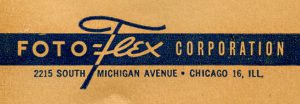 Photography is a hobby that can get expensive. With all the different styles of cameras, lenses, flashes, filters, cases, film, and other accessories, for the professional or enthusiast photographer, the rabbit hole can get quite deep.
Photography is a hobby that can get expensive. With all the different styles of cameras, lenses, flashes, filters, cases, film, and other accessories, for the professional or enthusiast photographer, the rabbit hole can get quite deep.
For many people though, a camera is just a thing that makes photos. These people don’t care about the specifications of a lens, flash sync speed, or the reciprocity of film. They just want something that goes click and makes a picture.
Over the past 100 or so years, there have been companies there to make simple and cheap cameras for these people. From the cardboard box cameras of the early 20th century to disposable plastic cameras, there is something for everyone.
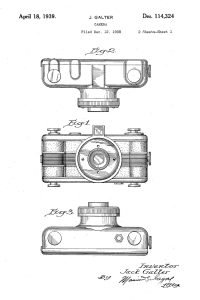
Many of these cheap cameras came from a huge number of Chicago based companies with names like Utility Manufacturing Company, Herold, Spartus, and Zenith. Men like Jack Galter and William H. Grafft made successful businesses out of building these cheap cameras. Selling for anywhere from $1 to $10, these cameras often doubled in value each time you loaded in a new roll of film.
The Foto-Flex was built in Chicago, Illinois by a company called the Hadds Mfg. Co. The name “Hadds Mfg. Co.” appears only on a sticker inside the film compartment and nowhere else on the camera’s box or in it’s documentation. In my research for this article, other than for other articles about the Foto-Flex, I could not find any information about Hadds Mfg. Co. whatsoever. Based on the huge number of inexpensive cameras that were made in Chicago in the mid 20th century, my best guess is that this name was an alias for one of the many other Chicago based camera makers of the era.

There is very little information online about this camera, but in my research for this article, I found the announcement to the right for the Foto-Flex in the June 1947 issue of Popular Photography, suggesting that was the first year it was available.
Selling for just $7.95, which when adjusted for inflation, compares to just under $100 today, it was likely one of the cheapest cameras you could buy at the time. The announcement says that the camera is all metal, which isn’t true of the one I had for this review, suggesting that perhaps there were both all-metal and plastic variations available, or perhaps that the announcement was wrong.
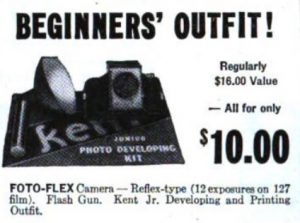
I found other mentions for the camera through 1948, such as the ad to the left for a $10 outfit including a flash gun and Kent Jr. developing kit. The inclusion of a flash in the kit is interesting as there is no way that I can see to connect a flash to the camera! The Foto-Flex seems to have disappeared by 1949 however, suggesting a short lifespan or that it likely moved to some other type of sub-retail sales channel.
Normally in this section of a review, I like to include contemporary reviews of a product or some other historical documentation for the camera, but for cheap cameras like the Foto-Flex, no reputable publications would have wasted their time, and it’s unlikely anything was ever written about it.
Today, cameras like the Foto-Flex are collectible, not because of their value as a camera, but as a curiosity by those who like lo-fi technology. Sites like Marcy Merrill’s Junk Store Cameras champion these cheap cameras, giving exposure to models that most other sites would likely ignore.
The Foto-Flex is an interesting camera that when used to it’s strengths, does accomplish the task of making a photo, it’s just not one that will do it with much fanfare!
My Thoughts
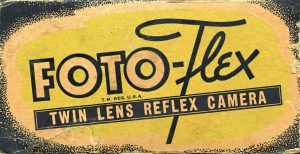 Cheap cameras are interesting to me for two reasons. First, I am intrigued at how much you can strip away from something and still have it accomplish it’s intended purpose. A camera can be loaded with tons of electronics, advanced central processing units, and high resolution digital censors, or it could be a cardboard box with a pinhole lens.
Cheap cameras are interesting to me for two reasons. First, I am intrigued at how much you can strip away from something and still have it accomplish it’s intended purpose. A camera can be loaded with tons of electronics, advanced central processing units, and high resolution digital censors, or it could be a cardboard box with a pinhole lens.
The second is that cheap cameras often make the most distinct looking images. I could show you dozens of pictures shot with a huge number of high end 6×6 TLRs or 35mm auto focus SLRs and you’d struggle to differentiate which cameras shot which images. That’s not true of simple cameras with meniscus lenses that have a lack of sharpness near the edges, strong vignetting, haze, or any number of optical aberrations. Photographs shot through cheap cameras often have a heck of a lot more character, which often enhances the overall look of the image.
When my friend and camera collector Adam Paul got his hands on a cheap midcentury twin lens camera called the Foto-Flex, I loved the look of the images he shared with me, so I sought out to find one of my own. Although these cameras aren’t super common these days, I got lucky pretty quickly and picked up this example in it’s original box for about $10.

If it’s not already obvious, the Foto-Flex is a cheaply made camera. Made almost entirely of plastic, with a weight of 359 grams, the camera doesn’t have much to it. It is literally a hollow plastic box with a plastic viewfinder and plastic lens with a spot to load in some film Although some people might refer to this camera as a TLR, a more appropriate description is that of a twin-lens box camera, which is exactly what it is.

As you’d expect from a box camera, the top plate doesn’t offer much to see other than the folding lid for the waist level viewfinder, and the film advance knob on the left. The built in strap handle is connected to the top plate, opposite of the film advance knob.
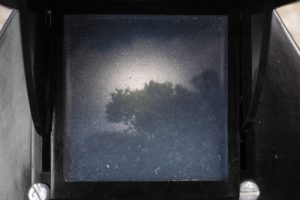
One of the Foto-Flex’s most appealing features is the life size ground glass viewfinder, which approximates the actual size of the 4cm x 4cm images that the camera can expose.
Although much larger than the small viewfinders atop many early 20th century box cameras, the one on the Foto-Flex is strangely dark. Normally, with the dimmest viewfinders, you can still get a good look at your composition in bright light.
Not so with the Foto-Flex. The image to the left shows what you see when pointed at a tree outdoors in good lighting. The center of the image is barely visible, with strong vignetting near the edges and corners. If you were to use this camera indoors, the image is almost impossible to see. This is in stark contrast to other “Brilliant” viewfinder cameras of the same era.
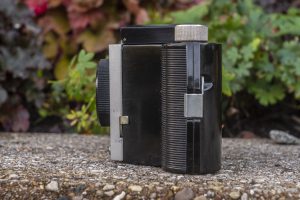
Both sides of the camera had metal latches which must be raised to open the rear film compartment. Make sure that both sides are completely raised before attempting to remove the rear back as the body is made of brittle plastic which can crack if you pull on it too hard.
Also notice that from this side, you can see the lever that controls the shutter’s Instant and Time (Bulb) mode. Although I don’t show it, but the other side of the camera has the shutter release lever.
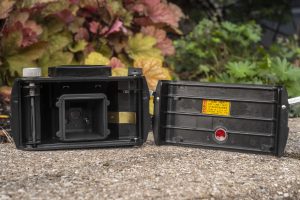
With the back off, we see the film compartment. Film transports from right to left onto regular 127 spools. If you are planning on buying a Foto-Flex to shoot, it helps if there is an empty spool that you can move over to become the take up spool.
As was common with many cheap cameras with simple lenses, the film plane is curved, which helps minimize softness and distortion near the edges of the exposed image. There is no proper film pressure plate on the inside of the door, although curved metal ribs help guide the film across the plane.
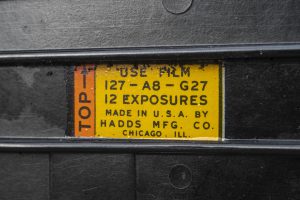
On the inside of the door, above the opening for the red window, is a decal reminding you what type of film to use. This decal is the only place anywhere on the camera or in it’s documentation, that the company “Hadds Mfg. Co, Chicago, Ill.” is mentioned. It is highly likely that this name is an alias of one of the many other inexpensive camera makers based out of Chicago at this time.
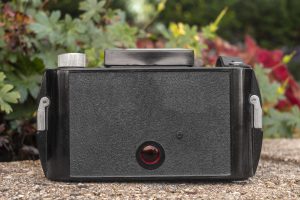
Around back, there’s nothing much to see, other than the back side of the red window which is used to read the exposure numbers on 127 film’s backing paper. Numbers 1 through 12 are shown through this window to indicate which exposure you are on. The Foto-Flex does not have any sort of double image prevention, so you must be sure to advance the film before every exposure. Also, do not go beyond the next exposure, as there is no way to rewind the film either.
I don’t show it, but there is nothing on the bottom of the camera, not even a tripod socket.
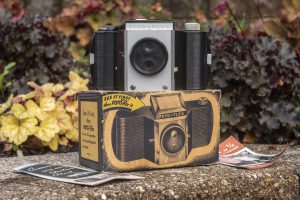
The Foto-Flex is a fixed focus, fixed aperture, single speed camera. The shutter release is on the front of the camera, to the right of the lens, in easy reach of the photographer’s right finger. A lever on the camera’s left side (to the right of the shutter) changes the shutter from Instant mode, which I estimate to be around 1/50 second, to a Timed mode in which the shutter remains open for as long as you hold the shutter release down. As you might expect, using the camera in this mode requires it to be stabilized on a table or flat surface.
There is no option for a threaded cable release socket or any way to synchronize the shutter with a flash. I suppose you could set the shutter to the Timed mode, open it up, manually fire a flash, and then close the shutter if you really wanted to use a flash.
I could not find any information about the f/stop of the lens, but it is probably somewhere between f/11 and f/16 to maximize depth of field, which is how the camera can achieve focus from 6 feet to infinity like the manual suggests.
On the front of the camera, despite having what looks to be a large black ring with knurled edges around both the taking and viewing lenses, this is just cosmetic and does not do anything. Do not try to twist this ring as the cheap construction of the camera could possibly cause it to crack.
There really isn’t anything else to say about the Foto-Flex. It’s a cheaply made mostly plastic camera with a very dim viewfinder, a fixed focus meniscus lens, a single shutter speed, and no adjustment for aperture. How bad could it be?
My Results
For the first (and likely only) roll I’ll ever shoot through the Foto-Flex, I chose a semi-expired roll of Rerapan 100. I haven’t always had the best of luck with this film as I find that it is inconsistent with exposure, and often returns images with more contrast that I’d like to see, but I wasn’t willing to sacrifice any of my precious Supre-Tone 127 film. There is no way of controlling exposure on the camera in Instant mode, and I thought that perhaps a 100 speed might be a little too fast for this camera, but shooting it on a dreary late winter day, I figured the lack of bright light would compensate for it.
Earlier in this review I mentioned that the appeal of old cameras for me are the distinct looking “imperfect” images they make, and the Foto-Flex definitely delivers in that regard. Each of the images above has pretty much every possible optical anomaly you could have in a black and white image. Extreme softness and vignetting in the corners, vague and undefined out of focus details, low contrast, and sharpness in the center that quickly fades as you get near the edges. There are those out there who might see these images and say they are the worst they’ve ever seen from a camera.
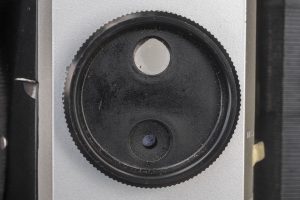
But therein lies the camera’s appeal. The quality of images the Foto-Flex delivers can only be made by a camera like the Foto-Flex, and for that reason, I love it! These kinds of images have character and make it worth owning a Foto Flex and loading in a roll of film or two.
Although I did like the images I got from it, and the lack of any exposure control was not an issue on the 100 speed Rerapan, using the Foto-Flex was not all roses.
My biggest complaint about the camera is it’s incredibly dark viewfinder. Using a simple optical lens and fixed mirror that reflects light onto a frosted screen, the image through the viewfinder is very hard to see outdoors. Take the camera inside, and the image almost completely disappears. I had thought that perhaps the reflective mirror had desilvered, making the viewfinder image darker than it should be, but looking backwards through the viewfinder “lens”, the mirror appeared to be in tact with only a few pieces of dust on it. Although a simple lens, the viewfinder lens is physically larger than the taking lens, so I would have thought that it should be able to pass through enough light to make a decently bright image, but that wasn’t the case.
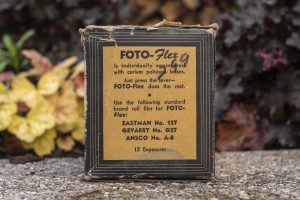
Using the Foto-Flex’s viewfinder was downright painful. So painful in fact, that about halfway through the roll, I stopped using it, and simply pointed the camera at my subject at eye level and shot away. Since the lens is fixed focus, anything more than 10 feet away should be in focus, and I wasn’t trying to critically frame any fast moving children, so I figured what the hell.
Viewfinder aside, the Foto-Flex is similar in use to a huge number of other simple cameras from the era. It’s use of 127 film allows it to be slightly smaller than other cheap roll film cameras, and it’s meniscus lens produces images of good enough quality that it likely would have satisfied anyone in the market for an $8 camera.
I am happy I own this camera, and I did enjoy using it, but I am glad I didn’t pay more than $10 for it, nor should you. If you find yourself in a situation where you have the opportunity to pick one of these up cheap, go for it, just make sure you understand what you’re buying.
Related Posts You Might Enjoy
External Links
https://www.junkstorecameras.com/project/foto-flex-tlr-camera/
https://www.collection-appareils.fr/x/html/camera-725-Foto-Flex_Foto-Flex.html

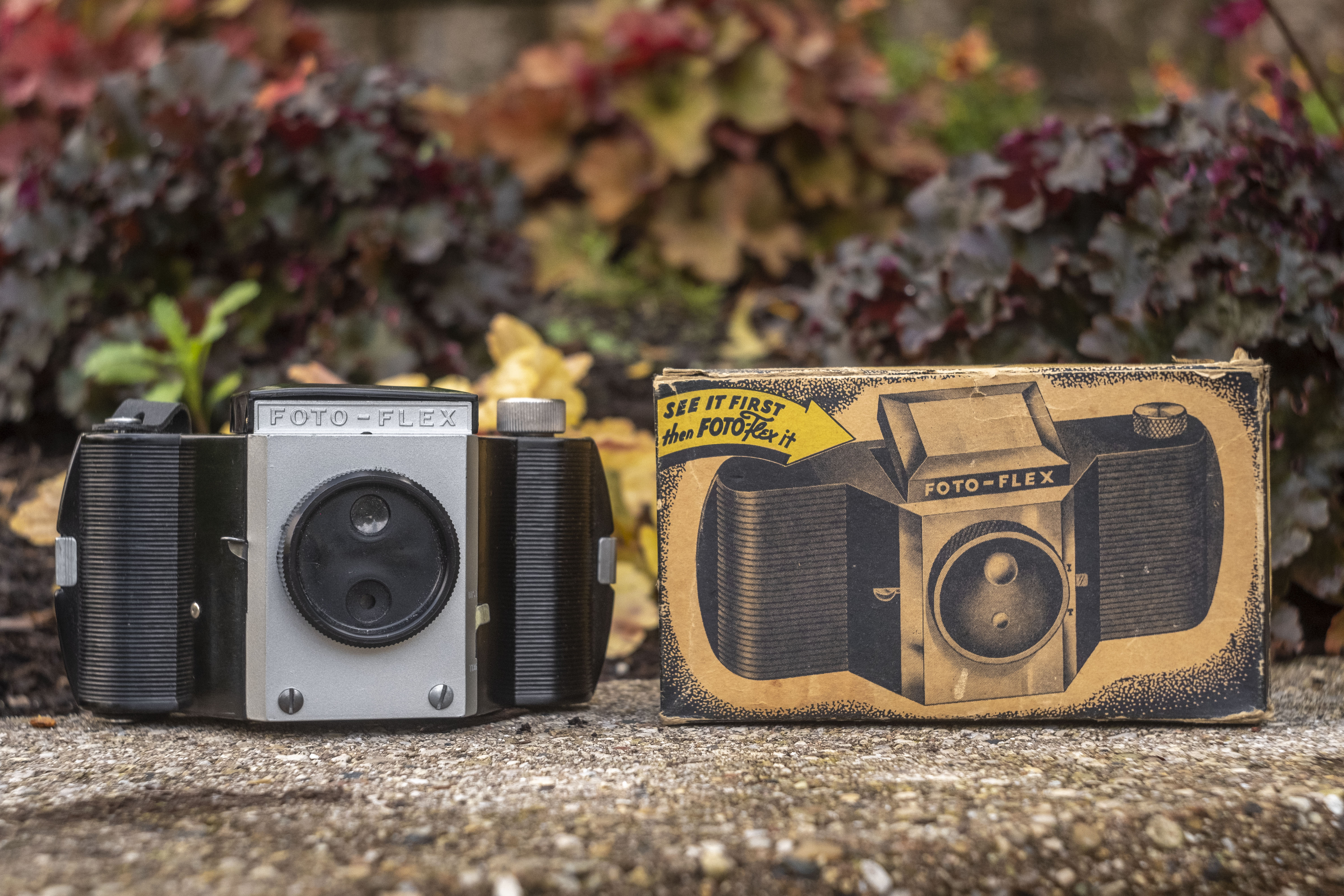
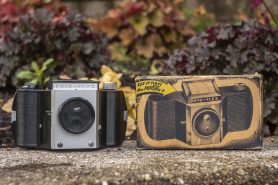
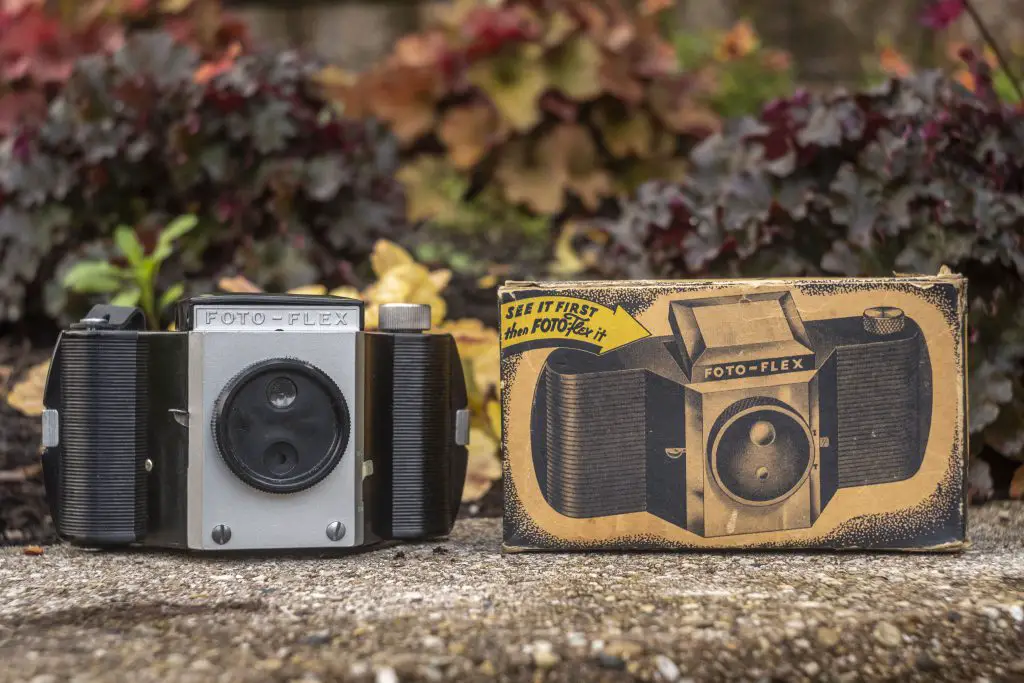















A “cerium polished” lens. Ooooohh, baby!
Yes, this surprised me, as cerium polish is usually used for glass polishing. Does this indicate that the lens is glass and not plastic, I wonder?
It is plausible that the lens is polished, but apart from taking it apart and trying to scratch it to see how soft it is, there is no information anywhere online about the lens in this camera. My instinct is that it’s still plastic and the ‘cerium polished’ line is just a gimmick, used by the company to make it sound more sophisticated than it really is. Who knows though, maybe they sprung the extra dollar or whatever it would have cost to use a glass, instead of plastic lens in this thing.
Mike, given expectations of the era, this camera produced some surprisingly sharp images, I’m referring to the Walt advertising board and the digger truck, but others, and considering you had absolutely no control over aperture and shutter speed to account for it, fared much less well. Camera shake, perhaps? A fare amount of vignetting, but non-photographers probably would have accepted it as normal, not knowing any better.
The viewfinder was likely dark because of the puny aperture on the viewing lens (at least f/8, I’d say). Since Fresnel screens weren’t a thing back then, any TTL viewfinder in that era would get uncomfortably dark even with f/5.6 lenses. I was wondering how bad it’d be from the first moment I saw the camera, and my fears proved correct.
I am sure your right, but I have used other brilliant finder twin lens box cameras which were much brighter than the Foto-Flex. It was shockingly dark! Still a cool camera, in a lo-fi kinda way!